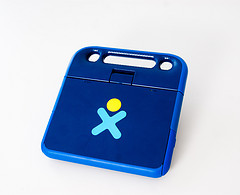Part 2 of a review of the XO-1.5
Over 90,000 Uruguayan high school students will receive a new XO-1.5 HS (High School edition) laptop. So how is it different from the XO-1 that their younger classmates have?
From the outside, the XO-1.5 HS has the same feel — it’s the same size, and the same antenna ears… though they feel different somehow in dark blue. The color variation on the backplate is more limited — there may be just one set of colors to match the dark blue casing.
To make it easier to use for high school students, the keyboard features larger keys for larger fingers — and it’s now a standard responsive, ‘clicky’ keyboard rather than a waterresistant membrane. Its light/dark blue color scheme represents Uruguay’s national colors, more subtler than the bright green of the other XOs.
Since we redesigned the keyboard, we took the opportunity to make a few other handy changes. The new keyboard screws in and pops out without dismantling the bottom of the XO — taking 2 minutes rather than 15 to swap one out.
I tried it myself during my first XO teardown – the keyboard was probably the easiest thing for me to get out. We did a half tear down and photographed it, so we can also add guidelines for upgrading your disk on the 1.5’s motherboard. And now people seem to be making hybrids of XO-1.5s with the new keyboard (see our Flickr stream for more). I’ll post again when the new repair guide section is ready.





